Nursing Care for Total Knee Replacement Surgery: A Case Study
VerifiedAdded on 2022/11/14
|12
|2972
|442
AI Summary
This article presents evidence-based nursing care for total knee replacement surgery before and after the operation. It focuses on a case study of a 74-year-old patient having right total knee replacement surgery. The article discusses potential clinical issues, prioritized interventions with rationales, and a discharge plan.
Contribute Materials
Your contribution can guide someone’s learning journey. Share your
documents today.

Nursing the Surgical Patient 1
Nursing the Surgical Patient
Name of the Author
Name of the University
Nursing the Surgical Patient
Name of the Author
Name of the University
Secure Best Marks with AI Grader
Need help grading? Try our AI Grader for instant feedback on your assignments.
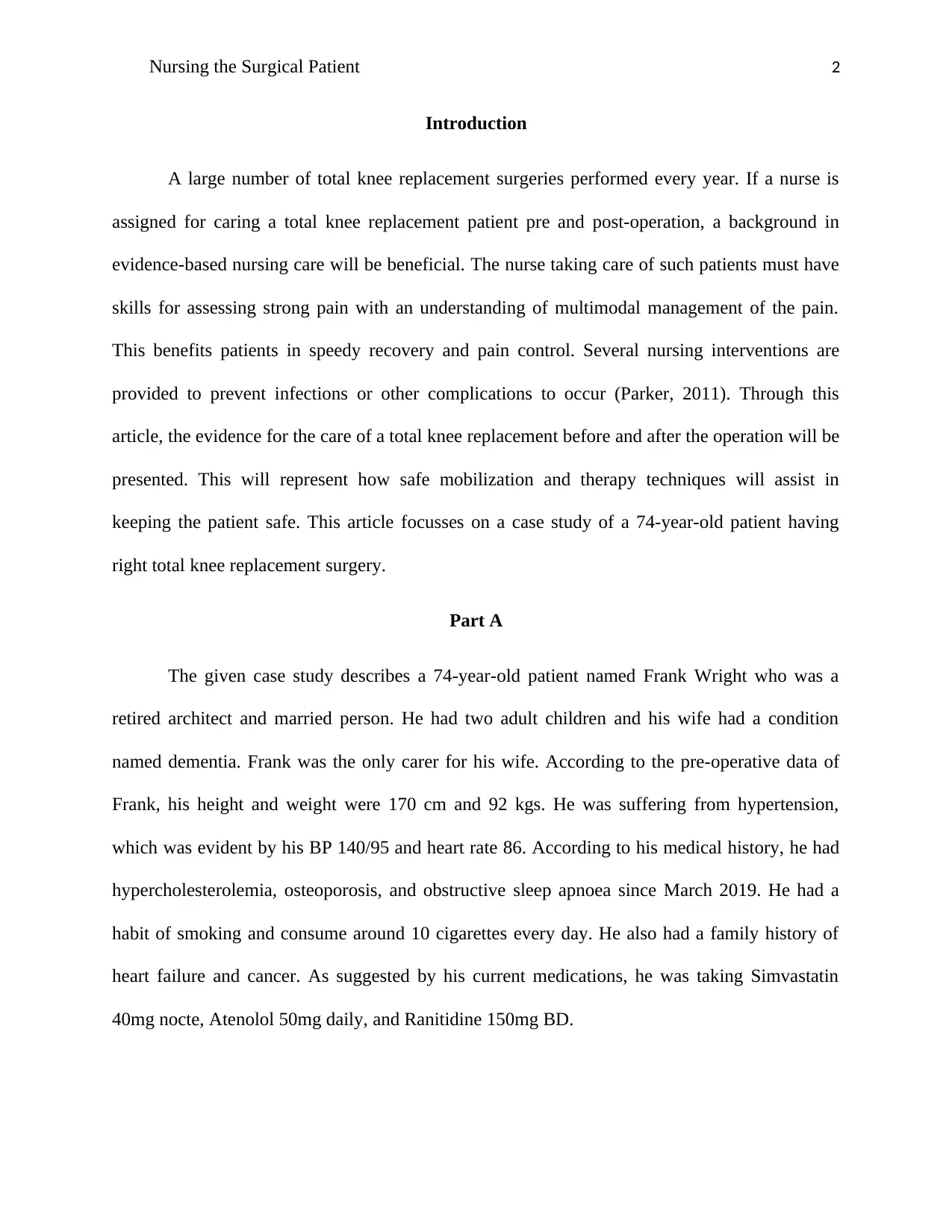
Nursing the Surgical Patient 2
Introduction
A large number of total knee replacement surgeries performed every year. If a nurse is
assigned for caring a total knee replacement patient pre and post-operation, a background in
evidence-based nursing care will be beneficial. The nurse taking care of such patients must have
skills for assessing strong pain with an understanding of multimodal management of the pain.
This benefits patients in speedy recovery and pain control. Several nursing interventions are
provided to prevent infections or other complications to occur (Parker, 2011). Through this
article, the evidence for the care of a total knee replacement before and after the operation will be
presented. This will represent how safe mobilization and therapy techniques will assist in
keeping the patient safe. This article focusses on a case study of a 74-year-old patient having
right total knee replacement surgery.
Part A
The given case study describes a 74-year-old patient named Frank Wright who was a
retired architect and married person. He had two adult children and his wife had a condition
named dementia. Frank was the only carer for his wife. According to the pre-operative data of
Frank, his height and weight were 170 cm and 92 kgs. He was suffering from hypertension,
which was evident by his BP 140/95 and heart rate 86. According to his medical history, he had
hypercholesterolemia, osteoporosis, and obstructive sleep apnoea since March 2019. He had a
habit of smoking and consume around 10 cigarettes every day. He also had a family history of
heart failure and cancer. As suggested by his current medications, he was taking Simvastatin
40mg nocte, Atenolol 50mg daily, and Ranitidine 150mg BD.
Introduction
A large number of total knee replacement surgeries performed every year. If a nurse is
assigned for caring a total knee replacement patient pre and post-operation, a background in
evidence-based nursing care will be beneficial. The nurse taking care of such patients must have
skills for assessing strong pain with an understanding of multimodal management of the pain.
This benefits patients in speedy recovery and pain control. Several nursing interventions are
provided to prevent infections or other complications to occur (Parker, 2011). Through this
article, the evidence for the care of a total knee replacement before and after the operation will be
presented. This will represent how safe mobilization and therapy techniques will assist in
keeping the patient safe. This article focusses on a case study of a 74-year-old patient having
right total knee replacement surgery.
Part A
The given case study describes a 74-year-old patient named Frank Wright who was a
retired architect and married person. He had two adult children and his wife had a condition
named dementia. Frank was the only carer for his wife. According to the pre-operative data of
Frank, his height and weight were 170 cm and 92 kgs. He was suffering from hypertension,
which was evident by his BP 140/95 and heart rate 86. According to his medical history, he had
hypercholesterolemia, osteoporosis, and obstructive sleep apnoea since March 2019. He had a
habit of smoking and consume around 10 cigarettes every day. He also had a family history of
heart failure and cancer. As suggested by his current medications, he was taking Simvastatin
40mg nocte, Atenolol 50mg daily, and Ranitidine 150mg BD.
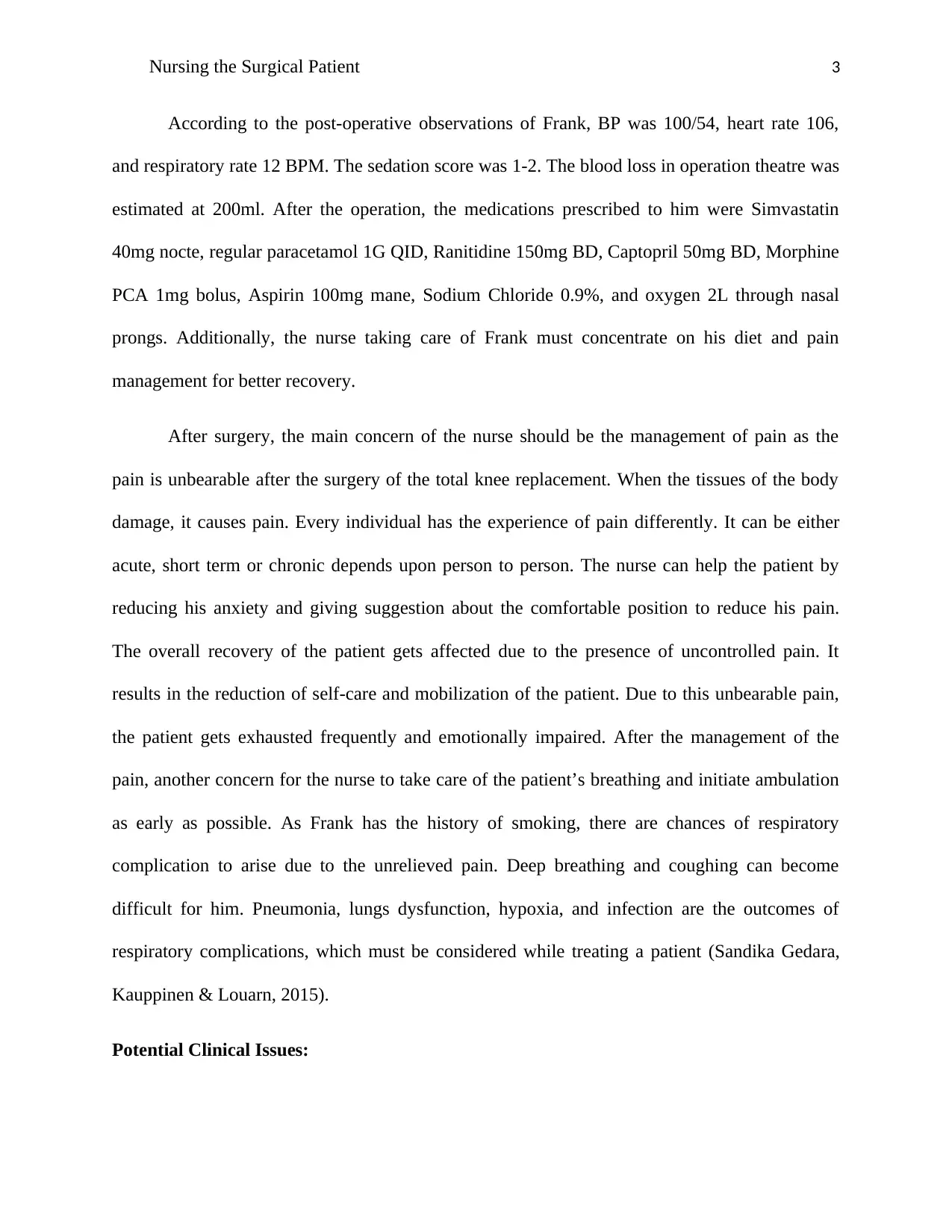
Nursing the Surgical Patient 3
According to the post-operative observations of Frank, BP was 100/54, heart rate 106,
and respiratory rate 12 BPM. The sedation score was 1-2. The blood loss in operation theatre was
estimated at 200ml. After the operation, the medications prescribed to him were Simvastatin
40mg nocte, regular paracetamol 1G QID, Ranitidine 150mg BD, Captopril 50mg BD, Morphine
PCA 1mg bolus, Aspirin 100mg mane, Sodium Chloride 0.9%, and oxygen 2L through nasal
prongs. Additionally, the nurse taking care of Frank must concentrate on his diet and pain
management for better recovery.
After surgery, the main concern of the nurse should be the management of pain as the
pain is unbearable after the surgery of the total knee replacement. When the tissues of the body
damage, it causes pain. Every individual has the experience of pain differently. It can be either
acute, short term or chronic depends upon person to person. The nurse can help the patient by
reducing his anxiety and giving suggestion about the comfortable position to reduce his pain.
The overall recovery of the patient gets affected due to the presence of uncontrolled pain. It
results in the reduction of self-care and mobilization of the patient. Due to this unbearable pain,
the patient gets exhausted frequently and emotionally impaired. After the management of the
pain, another concern for the nurse to take care of the patient’s breathing and initiate ambulation
as early as possible. As Frank has the history of smoking, there are chances of respiratory
complication to arise due to the unrelieved pain. Deep breathing and coughing can become
difficult for him. Pneumonia, lungs dysfunction, hypoxia, and infection are the outcomes of
respiratory complications, which must be considered while treating a patient (Sandika Gedara,
Kauppinen & Louarn, 2015).
Potential Clinical Issues:
According to the post-operative observations of Frank, BP was 100/54, heart rate 106,
and respiratory rate 12 BPM. The sedation score was 1-2. The blood loss in operation theatre was
estimated at 200ml. After the operation, the medications prescribed to him were Simvastatin
40mg nocte, regular paracetamol 1G QID, Ranitidine 150mg BD, Captopril 50mg BD, Morphine
PCA 1mg bolus, Aspirin 100mg mane, Sodium Chloride 0.9%, and oxygen 2L through nasal
prongs. Additionally, the nurse taking care of Frank must concentrate on his diet and pain
management for better recovery.
After surgery, the main concern of the nurse should be the management of pain as the
pain is unbearable after the surgery of the total knee replacement. When the tissues of the body
damage, it causes pain. Every individual has the experience of pain differently. It can be either
acute, short term or chronic depends upon person to person. The nurse can help the patient by
reducing his anxiety and giving suggestion about the comfortable position to reduce his pain.
The overall recovery of the patient gets affected due to the presence of uncontrolled pain. It
results in the reduction of self-care and mobilization of the patient. Due to this unbearable pain,
the patient gets exhausted frequently and emotionally impaired. After the management of the
pain, another concern for the nurse to take care of the patient’s breathing and initiate ambulation
as early as possible. As Frank has the history of smoking, there are chances of respiratory
complication to arise due to the unrelieved pain. Deep breathing and coughing can become
difficult for him. Pneumonia, lungs dysfunction, hypoxia, and infection are the outcomes of
respiratory complications, which must be considered while treating a patient (Sandika Gedara,
Kauppinen & Louarn, 2015).
Potential Clinical Issues:
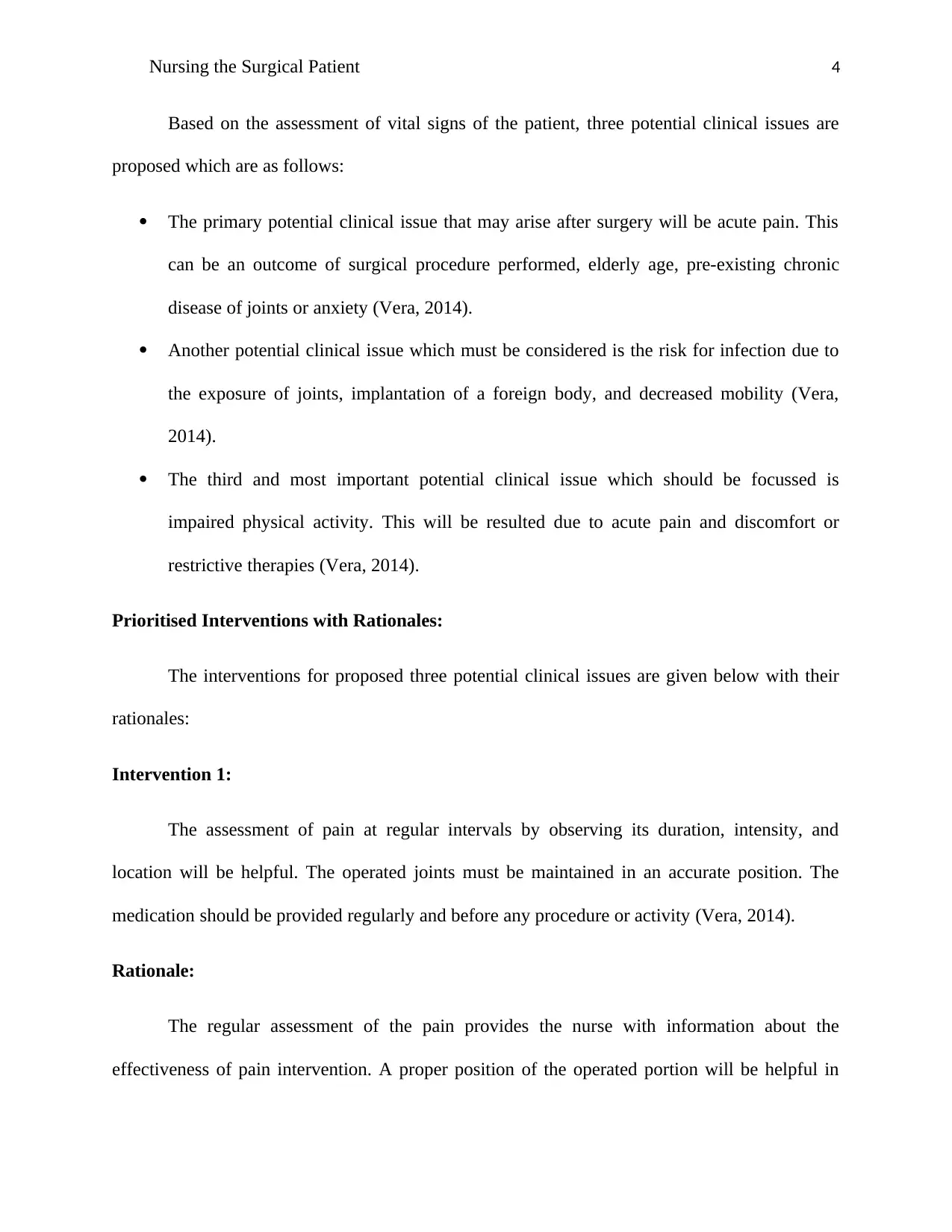
Nursing the Surgical Patient 4
Based on the assessment of vital signs of the patient, three potential clinical issues are
proposed which are as follows:
The primary potential clinical issue that may arise after surgery will be acute pain. This
can be an outcome of surgical procedure performed, elderly age, pre-existing chronic
disease of joints or anxiety (Vera, 2014).
Another potential clinical issue which must be considered is the risk for infection due to
the exposure of joints, implantation of a foreign body, and decreased mobility (Vera,
2014).
The third and most important potential clinical issue which should be focussed is
impaired physical activity. This will be resulted due to acute pain and discomfort or
restrictive therapies (Vera, 2014).
Prioritised Interventions with Rationales:
The interventions for proposed three potential clinical issues are given below with their
rationales:
Intervention 1:
The assessment of pain at regular intervals by observing its duration, intensity, and
location will be helpful. The operated joints must be maintained in an accurate position. The
medication should be provided regularly and before any procedure or activity (Vera, 2014).
Rationale:
The regular assessment of the pain provides the nurse with information about the
effectiveness of pain intervention. A proper position of the operated portion will be helpful in
Based on the assessment of vital signs of the patient, three potential clinical issues are
proposed which are as follows:
The primary potential clinical issue that may arise after surgery will be acute pain. This
can be an outcome of surgical procedure performed, elderly age, pre-existing chronic
disease of joints or anxiety (Vera, 2014).
Another potential clinical issue which must be considered is the risk for infection due to
the exposure of joints, implantation of a foreign body, and decreased mobility (Vera,
2014).
The third and most important potential clinical issue which should be focussed is
impaired physical activity. This will be resulted due to acute pain and discomfort or
restrictive therapies (Vera, 2014).
Prioritised Interventions with Rationales:
The interventions for proposed three potential clinical issues are given below with their
rationales:
Intervention 1:
The assessment of pain at regular intervals by observing its duration, intensity, and
location will be helpful. The operated joints must be maintained in an accurate position. The
medication should be provided regularly and before any procedure or activity (Vera, 2014).
Rationale:
The regular assessment of the pain provides the nurse with information about the
effectiveness of pain intervention. A proper position of the operated portion will be helpful in
Secure Best Marks with AI Grader
Need help grading? Try our AI Grader for instant feedback on your assignments.

Nursing the Surgical Patient 5
reducing muscle spasm and tension in the new prosthesis and tissues surrounding it. Regular
medication is as important as anything else because it will be helpful in reducing the tension of
the muscles and enhances participation due to the improvement in comfort level. As suggested
by a study, acute pain is the major cause of limited movement. Hence, it is necessary to manage
it (El Shemey & A. E. Elsaay, 2015). Additionally, if a patient is obese, it will affect his pain and
the cost of the treatment (McLawhorn, Southren, Wang, Marx & Dodwell, 2016).
Intervention 2:
The nurses should promote handwashing for everyone including staff and patient. While
changing the dressing, they must utilize strict aseptic techniques. Also, the patient should be
instructed not to scratch or touch incision. Monitoring of increased incisional pain and any
modification in pain features must be prioritised (Vera, 2014).
Rationale:
Regular hand washing is the best way to prevent infection. While changing the dressing,
use of aseptic techniques is the effective method to prevent contamination, which could result in
the removal of the prosthesis. If there is a sign of increased pain in the area of operation, this
could be a sign of a developing infection. Joint infections can be the major cause of the revision
of prosthesis. Thus, hand washing is needed to prevent prosthetic revision (Ratto et al., 2016).
Around 0.8 – 1.9% of total knee replacements have the development of late periprosthetic joint
infection (Bjerke-Kroll et al., 2014).
Intervention 3:
It is important to maintain the affected joint in the suggested position. The alignment of
the body should also be maintained while the patient is on the bed. Before initiating any
reducing muscle spasm and tension in the new prosthesis and tissues surrounding it. Regular
medication is as important as anything else because it will be helpful in reducing the tension of
the muscles and enhances participation due to the improvement in comfort level. As suggested
by a study, acute pain is the major cause of limited movement. Hence, it is necessary to manage
it (El Shemey & A. E. Elsaay, 2015). Additionally, if a patient is obese, it will affect his pain and
the cost of the treatment (McLawhorn, Southren, Wang, Marx & Dodwell, 2016).
Intervention 2:
The nurses should promote handwashing for everyone including staff and patient. While
changing the dressing, they must utilize strict aseptic techniques. Also, the patient should be
instructed not to scratch or touch incision. Monitoring of increased incisional pain and any
modification in pain features must be prioritised (Vera, 2014).
Rationale:
Regular hand washing is the best way to prevent infection. While changing the dressing,
use of aseptic techniques is the effective method to prevent contamination, which could result in
the removal of the prosthesis. If there is a sign of increased pain in the area of operation, this
could be a sign of a developing infection. Joint infections can be the major cause of the revision
of prosthesis. Thus, hand washing is needed to prevent prosthetic revision (Ratto et al., 2016).
Around 0.8 – 1.9% of total knee replacements have the development of late periprosthetic joint
infection (Bjerke-Kroll et al., 2014).
Intervention 3:
It is important to maintain the affected joint in the suggested position. The alignment of
the body should also be maintained while the patient is on the bed. Before initiating any
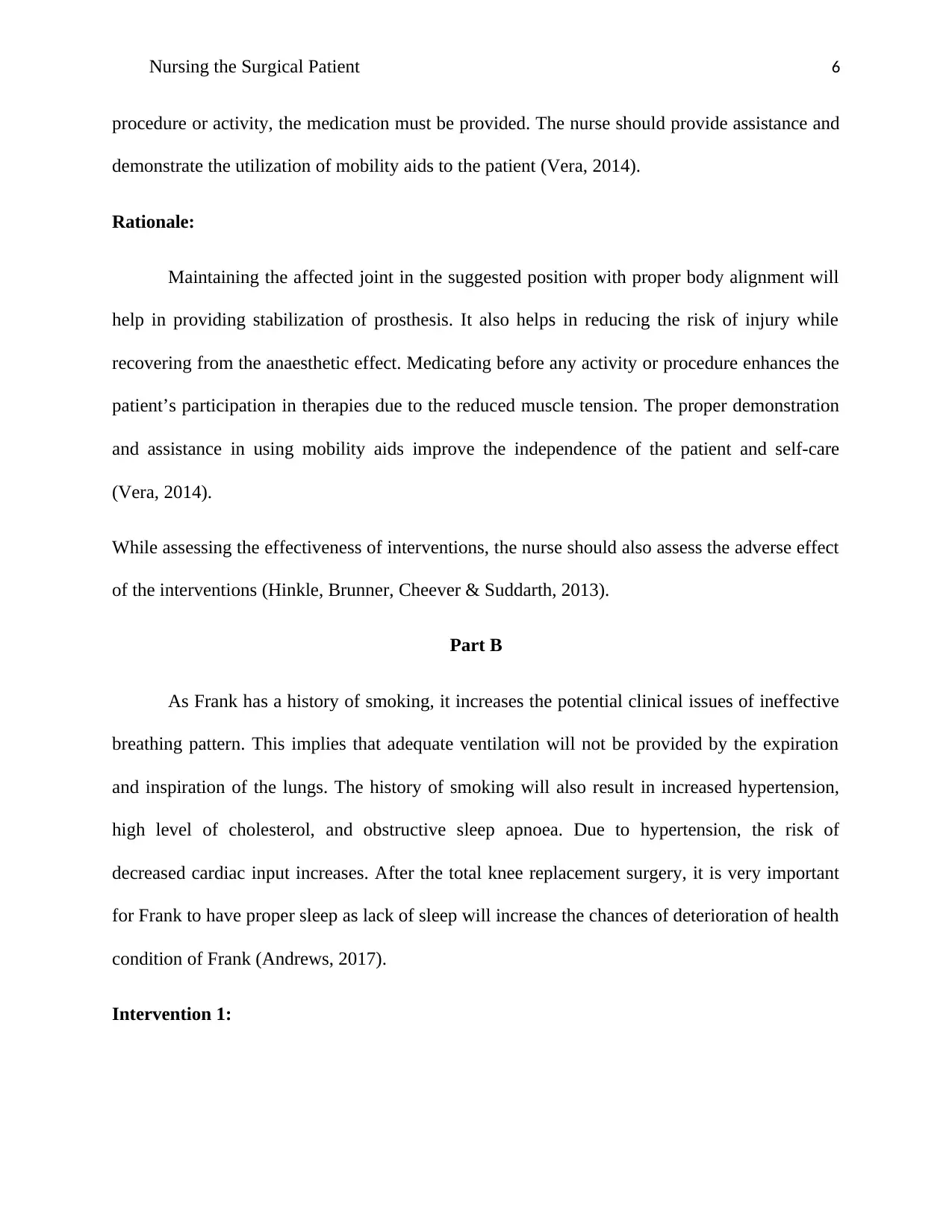
Nursing the Surgical Patient 6
procedure or activity, the medication must be provided. The nurse should provide assistance and
demonstrate the utilization of mobility aids to the patient (Vera, 2014).
Rationale:
Maintaining the affected joint in the suggested position with proper body alignment will
help in providing stabilization of prosthesis. It also helps in reducing the risk of injury while
recovering from the anaesthetic effect. Medicating before any activity or procedure enhances the
patient’s participation in therapies due to the reduced muscle tension. The proper demonstration
and assistance in using mobility aids improve the independence of the patient and self-care
(Vera, 2014).
While assessing the effectiveness of interventions, the nurse should also assess the adverse effect
of the interventions (Hinkle, Brunner, Cheever & Suddarth, 2013).
Part B
As Frank has a history of smoking, it increases the potential clinical issues of ineffective
breathing pattern. This implies that adequate ventilation will not be provided by the expiration
and inspiration of the lungs. The history of smoking will also result in increased hypertension,
high level of cholesterol, and obstructive sleep apnoea. Due to hypertension, the risk of
decreased cardiac input increases. After the total knee replacement surgery, it is very important
for Frank to have proper sleep as lack of sleep will increase the chances of deterioration of health
condition of Frank (Andrews, 2017).
Intervention 1:
procedure or activity, the medication must be provided. The nurse should provide assistance and
demonstrate the utilization of mobility aids to the patient (Vera, 2014).
Rationale:
Maintaining the affected joint in the suggested position with proper body alignment will
help in providing stabilization of prosthesis. It also helps in reducing the risk of injury while
recovering from the anaesthetic effect. Medicating before any activity or procedure enhances the
patient’s participation in therapies due to the reduced muscle tension. The proper demonstration
and assistance in using mobility aids improve the independence of the patient and self-care
(Vera, 2014).
While assessing the effectiveness of interventions, the nurse should also assess the adverse effect
of the interventions (Hinkle, Brunner, Cheever & Suddarth, 2013).
Part B
As Frank has a history of smoking, it increases the potential clinical issues of ineffective
breathing pattern. This implies that adequate ventilation will not be provided by the expiration
and inspiration of the lungs. The history of smoking will also result in increased hypertension,
high level of cholesterol, and obstructive sleep apnoea. Due to hypertension, the risk of
decreased cardiac input increases. After the total knee replacement surgery, it is very important
for Frank to have proper sleep as lack of sleep will increase the chances of deterioration of health
condition of Frank (Andrews, 2017).
Intervention 1:

Nursing the Surgical Patient 7
Ineffective breathing pattern can be prevented by maintaining the patient’s airway. It can
be performed by tilting the head, jaw hyperextension, and oral pharyngeal airway. Monitoring of
respiratory rate, expansion of the chest, flaring of nostrils, vital signs, and skin colour
continuously is required (do Canto & Almeida, 2013).
Rationale:
With the management of the airway, the obstruction of airway can be prevented. The
monitoring of vital signs and respiratory rate assures the effectiveness of respiration. If any
abnormality will be observed, the corrective measures will be taken instantly. In the case of
increased respiration, hypoxia will be suggested (Vera, 2014).
Intervention 2:
The regular assessment of the patient’s lab data is required to find contributing factors
such as blood cell count, cardiac markers, ABGs, etc. The blood pressure should be measured
and recorded in both thighs and arms. The intake of sodium should also be reduced if required
(Vera, 2014).
Rationale:
The regular assessment of lab data of the patient is necessary to monitor the health
condition of the patient to initiate treatment if needed. The blood pressure is essential to be
maintained to improve cardiac output and heart functioning. The intake of a high level of sodium
can increase blood pressure, hence to lower the blood pressure sodium intake should be
optimised (Vera, 2014).
Intervention 3:
Ineffective breathing pattern can be prevented by maintaining the patient’s airway. It can
be performed by tilting the head, jaw hyperextension, and oral pharyngeal airway. Monitoring of
respiratory rate, expansion of the chest, flaring of nostrils, vital signs, and skin colour
continuously is required (do Canto & Almeida, 2013).
Rationale:
With the management of the airway, the obstruction of airway can be prevented. The
monitoring of vital signs and respiratory rate assures the effectiveness of respiration. If any
abnormality will be observed, the corrective measures will be taken instantly. In the case of
increased respiration, hypoxia will be suggested (Vera, 2014).
Intervention 2:
The regular assessment of the patient’s lab data is required to find contributing factors
such as blood cell count, cardiac markers, ABGs, etc. The blood pressure should be measured
and recorded in both thighs and arms. The intake of sodium should also be reduced if required
(Vera, 2014).
Rationale:
The regular assessment of lab data of the patient is necessary to monitor the health
condition of the patient to initiate treatment if needed. The blood pressure is essential to be
maintained to improve cardiac output and heart functioning. The intake of a high level of sodium
can increase blood pressure, hence to lower the blood pressure sodium intake should be
optimised (Vera, 2014).
Intervention 3:
Paraphrase This Document
Need a fresh take? Get an instant paraphrase of this document with our AI Paraphraser
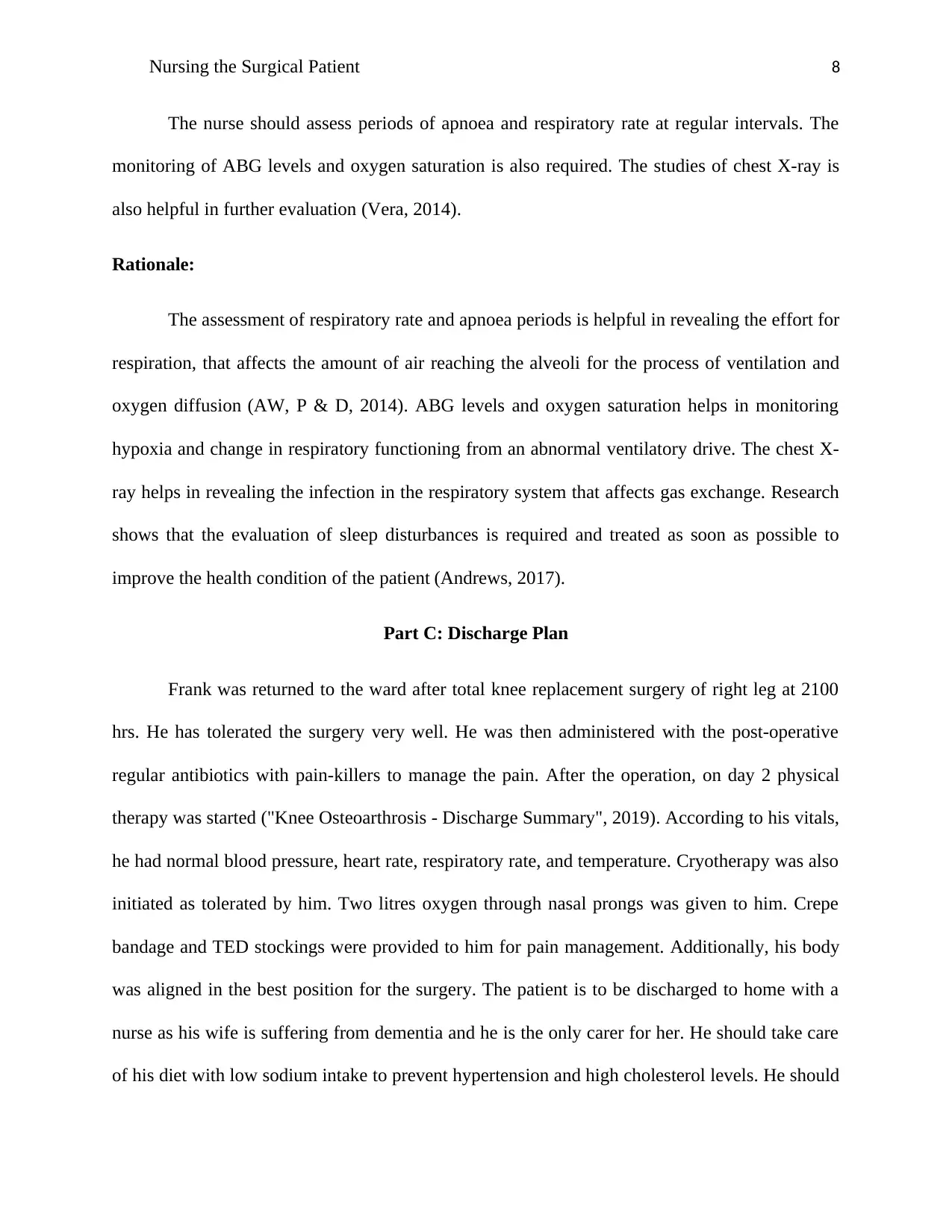
Nursing the Surgical Patient 8
The nurse should assess periods of apnoea and respiratory rate at regular intervals. The
monitoring of ABG levels and oxygen saturation is also required. The studies of chest X-ray is
also helpful in further evaluation (Vera, 2014).
Rationale:
The assessment of respiratory rate and apnoea periods is helpful in revealing the effort for
respiration, that affects the amount of air reaching the alveoli for the process of ventilation and
oxygen diffusion (AW, P & D, 2014). ABG levels and oxygen saturation helps in monitoring
hypoxia and change in respiratory functioning from an abnormal ventilatory drive. The chest X-
ray helps in revealing the infection in the respiratory system that affects gas exchange. Research
shows that the evaluation of sleep disturbances is required and treated as soon as possible to
improve the health condition of the patient (Andrews, 2017).
Part C: Discharge Plan
Frank was returned to the ward after total knee replacement surgery of right leg at 2100
hrs. He has tolerated the surgery very well. He was then administered with the post-operative
regular antibiotics with pain-killers to manage the pain. After the operation, on day 2 physical
therapy was started ("Knee Osteoarthrosis - Discharge Summary", 2019). According to his vitals,
he had normal blood pressure, heart rate, respiratory rate, and temperature. Cryotherapy was also
initiated as tolerated by him. Two litres oxygen through nasal prongs was given to him. Crepe
bandage and TED stockings were provided to him for pain management. Additionally, his body
was aligned in the best position for the surgery. The patient is to be discharged to home with a
nurse as his wife is suffering from dementia and he is the only carer for her. He should take care
of his diet with low sodium intake to prevent hypertension and high cholesterol levels. He should
The nurse should assess periods of apnoea and respiratory rate at regular intervals. The
monitoring of ABG levels and oxygen saturation is also required. The studies of chest X-ray is
also helpful in further evaluation (Vera, 2014).
Rationale:
The assessment of respiratory rate and apnoea periods is helpful in revealing the effort for
respiration, that affects the amount of air reaching the alveoli for the process of ventilation and
oxygen diffusion (AW, P & D, 2014). ABG levels and oxygen saturation helps in monitoring
hypoxia and change in respiratory functioning from an abnormal ventilatory drive. The chest X-
ray helps in revealing the infection in the respiratory system that affects gas exchange. Research
shows that the evaluation of sleep disturbances is required and treated as soon as possible to
improve the health condition of the patient (Andrews, 2017).
Part C: Discharge Plan
Frank was returned to the ward after total knee replacement surgery of right leg at 2100
hrs. He has tolerated the surgery very well. He was then administered with the post-operative
regular antibiotics with pain-killers to manage the pain. After the operation, on day 2 physical
therapy was started ("Knee Osteoarthrosis - Discharge Summary", 2019). According to his vitals,
he had normal blood pressure, heart rate, respiratory rate, and temperature. Cryotherapy was also
initiated as tolerated by him. Two litres oxygen through nasal prongs was given to him. Crepe
bandage and TED stockings were provided to him for pain management. Additionally, his body
was aligned in the best position for the surgery. The patient is to be discharged to home with a
nurse as his wife is suffering from dementia and he is the only carer for her. He should take care
of his diet with low sodium intake to prevent hypertension and high cholesterol levels. He should
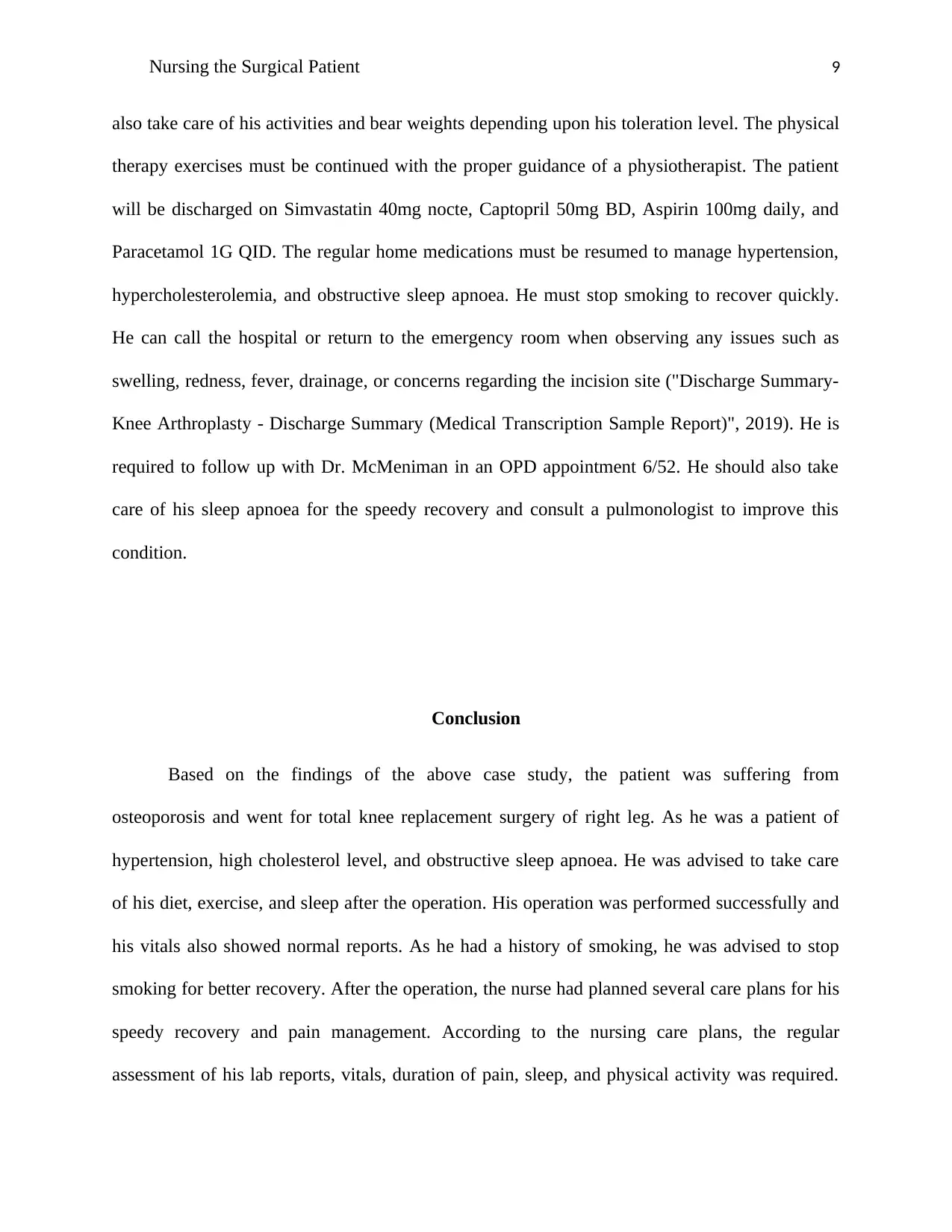
Nursing the Surgical Patient 9
also take care of his activities and bear weights depending upon his toleration level. The physical
therapy exercises must be continued with the proper guidance of a physiotherapist. The patient
will be discharged on Simvastatin 40mg nocte, Captopril 50mg BD, Aspirin 100mg daily, and
Paracetamol 1G QID. The regular home medications must be resumed to manage hypertension,
hypercholesterolemia, and obstructive sleep apnoea. He must stop smoking to recover quickly.
He can call the hospital or return to the emergency room when observing any issues such as
swelling, redness, fever, drainage, or concerns regarding the incision site ("Discharge Summary-
Knee Arthroplasty - Discharge Summary (Medical Transcription Sample Report)", 2019). He is
required to follow up with Dr. McMeniman in an OPD appointment 6/52. He should also take
care of his sleep apnoea for the speedy recovery and consult a pulmonologist to improve this
condition.
Conclusion
Based on the findings of the above case study, the patient was suffering from
osteoporosis and went for total knee replacement surgery of right leg. As he was a patient of
hypertension, high cholesterol level, and obstructive sleep apnoea. He was advised to take care
of his diet, exercise, and sleep after the operation. His operation was performed successfully and
his vitals also showed normal reports. As he had a history of smoking, he was advised to stop
smoking for better recovery. After the operation, the nurse had planned several care plans for his
speedy recovery and pain management. According to the nursing care plans, the regular
assessment of his lab reports, vitals, duration of pain, sleep, and physical activity was required.
also take care of his activities and bear weights depending upon his toleration level. The physical
therapy exercises must be continued with the proper guidance of a physiotherapist. The patient
will be discharged on Simvastatin 40mg nocte, Captopril 50mg BD, Aspirin 100mg daily, and
Paracetamol 1G QID. The regular home medications must be resumed to manage hypertension,
hypercholesterolemia, and obstructive sleep apnoea. He must stop smoking to recover quickly.
He can call the hospital or return to the emergency room when observing any issues such as
swelling, redness, fever, drainage, or concerns regarding the incision site ("Discharge Summary-
Knee Arthroplasty - Discharge Summary (Medical Transcription Sample Report)", 2019). He is
required to follow up with Dr. McMeniman in an OPD appointment 6/52. He should also take
care of his sleep apnoea for the speedy recovery and consult a pulmonologist to improve this
condition.
Conclusion
Based on the findings of the above case study, the patient was suffering from
osteoporosis and went for total knee replacement surgery of right leg. As he was a patient of
hypertension, high cholesterol level, and obstructive sleep apnoea. He was advised to take care
of his diet, exercise, and sleep after the operation. His operation was performed successfully and
his vitals also showed normal reports. As he had a history of smoking, he was advised to stop
smoking for better recovery. After the operation, the nurse had planned several care plans for his
speedy recovery and pain management. According to the nursing care plans, the regular
assessment of his lab reports, vitals, duration of pain, sleep, and physical activity was required.
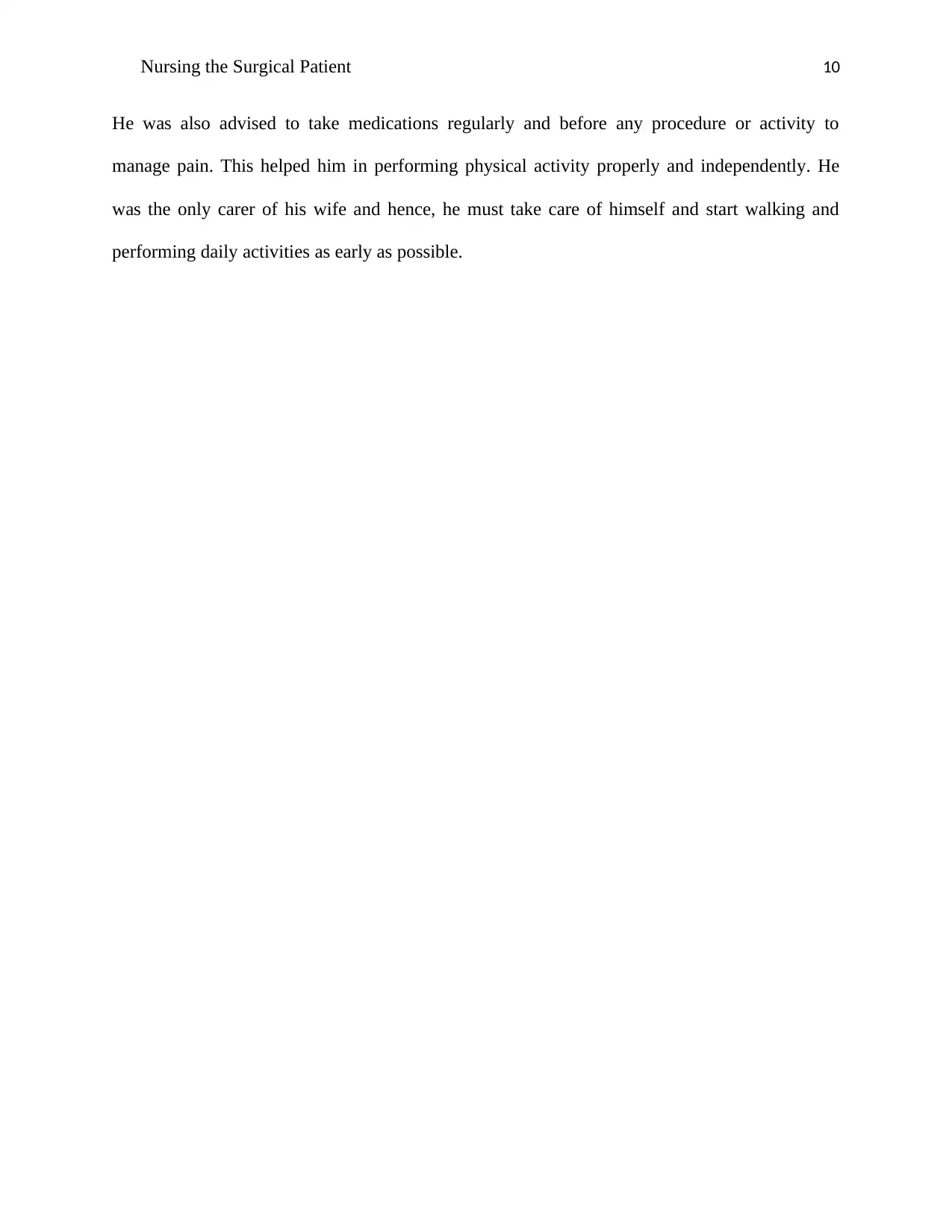
Nursing the Surgical Patient 10
He was also advised to take medications regularly and before any procedure or activity to
manage pain. This helped him in performing physical activity properly and independently. He
was the only carer of his wife and hence, he must take care of himself and start walking and
performing daily activities as early as possible.
He was also advised to take medications regularly and before any procedure or activity to
manage pain. This helped him in performing physical activity properly and independently. He
was the only carer of his wife and hence, he must take care of himself and start walking and
performing daily activities as early as possible.
Secure Best Marks with AI Grader
Need help grading? Try our AI Grader for instant feedback on your assignments.
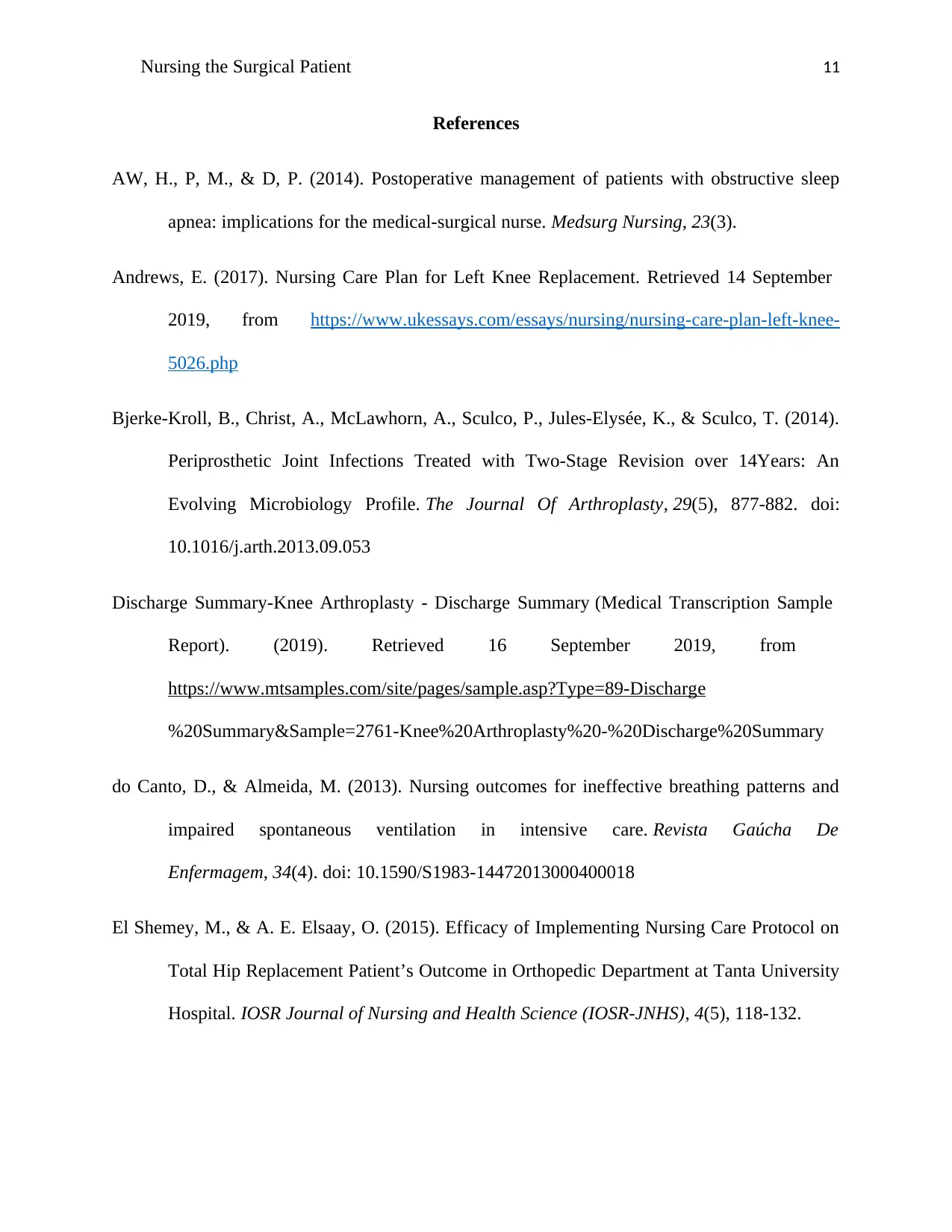
Nursing the Surgical Patient 11
References
AW, H., P, M., & D, P. (2014). Postoperative management of patients with obstructive sleep
apnea: implications for the medical-surgical nurse. Medsurg Nursing, 23(3).
Andrews, E. (2017). Nursing Care Plan for Left Knee Replacement. Retrieved 14 September
2019, from https://www.ukessays.com/essays/nursing/nursing-care-plan-left-knee-
5026.php
Bjerke-Kroll, B., Christ, A., McLawhorn, A., Sculco, P., Jules-Elysée, K., & Sculco, T. (2014).
Periprosthetic Joint Infections Treated with Two-Stage Revision over 14Years: An
Evolving Microbiology Profile. The Journal Of Arthroplasty, 29(5), 877-882. doi:
10.1016/j.arth.2013.09.053
Discharge Summary-Knee Arthroplasty - Discharge Summary (Medical Transcription Sample
Report). (2019). Retrieved 16 September 2019, from
https://www.mtsamples.com/site/pages/sample.asp?Type=89-Discharge
%20Summary&Sample=2761-Knee%20Arthroplasty%20-%20Discharge%20Summary
do Canto, D., & Almeida, M. (2013). Nursing outcomes for ineffective breathing patterns and
impaired spontaneous ventilation in intensive care. Revista Gaúcha De
Enfermagem, 34(4). doi: 10.1590/S1983-14472013000400018
El Shemey, M., & A. E. Elsaay, O. (2015). Efficacy of Implementing Nursing Care Protocol on
Total Hip Replacement Patient’s Outcome in Orthopedic Department at Tanta University
Hospital. IOSR Journal of Nursing and Health Science (IOSR-JNHS), 4(5), 118-132.
References
AW, H., P, M., & D, P. (2014). Postoperative management of patients with obstructive sleep
apnea: implications for the medical-surgical nurse. Medsurg Nursing, 23(3).
Andrews, E. (2017). Nursing Care Plan for Left Knee Replacement. Retrieved 14 September
2019, from https://www.ukessays.com/essays/nursing/nursing-care-plan-left-knee-
5026.php
Bjerke-Kroll, B., Christ, A., McLawhorn, A., Sculco, P., Jules-Elysée, K., & Sculco, T. (2014).
Periprosthetic Joint Infections Treated with Two-Stage Revision over 14Years: An
Evolving Microbiology Profile. The Journal Of Arthroplasty, 29(5), 877-882. doi:
10.1016/j.arth.2013.09.053
Discharge Summary-Knee Arthroplasty - Discharge Summary (Medical Transcription Sample
Report). (2019). Retrieved 16 September 2019, from
https://www.mtsamples.com/site/pages/sample.asp?Type=89-Discharge
%20Summary&Sample=2761-Knee%20Arthroplasty%20-%20Discharge%20Summary
do Canto, D., & Almeida, M. (2013). Nursing outcomes for ineffective breathing patterns and
impaired spontaneous ventilation in intensive care. Revista Gaúcha De
Enfermagem, 34(4). doi: 10.1590/S1983-14472013000400018
El Shemey, M., & A. E. Elsaay, O. (2015). Efficacy of Implementing Nursing Care Protocol on
Total Hip Replacement Patient’s Outcome in Orthopedic Department at Tanta University
Hospital. IOSR Journal of Nursing and Health Science (IOSR-JNHS), 4(5), 118-132.
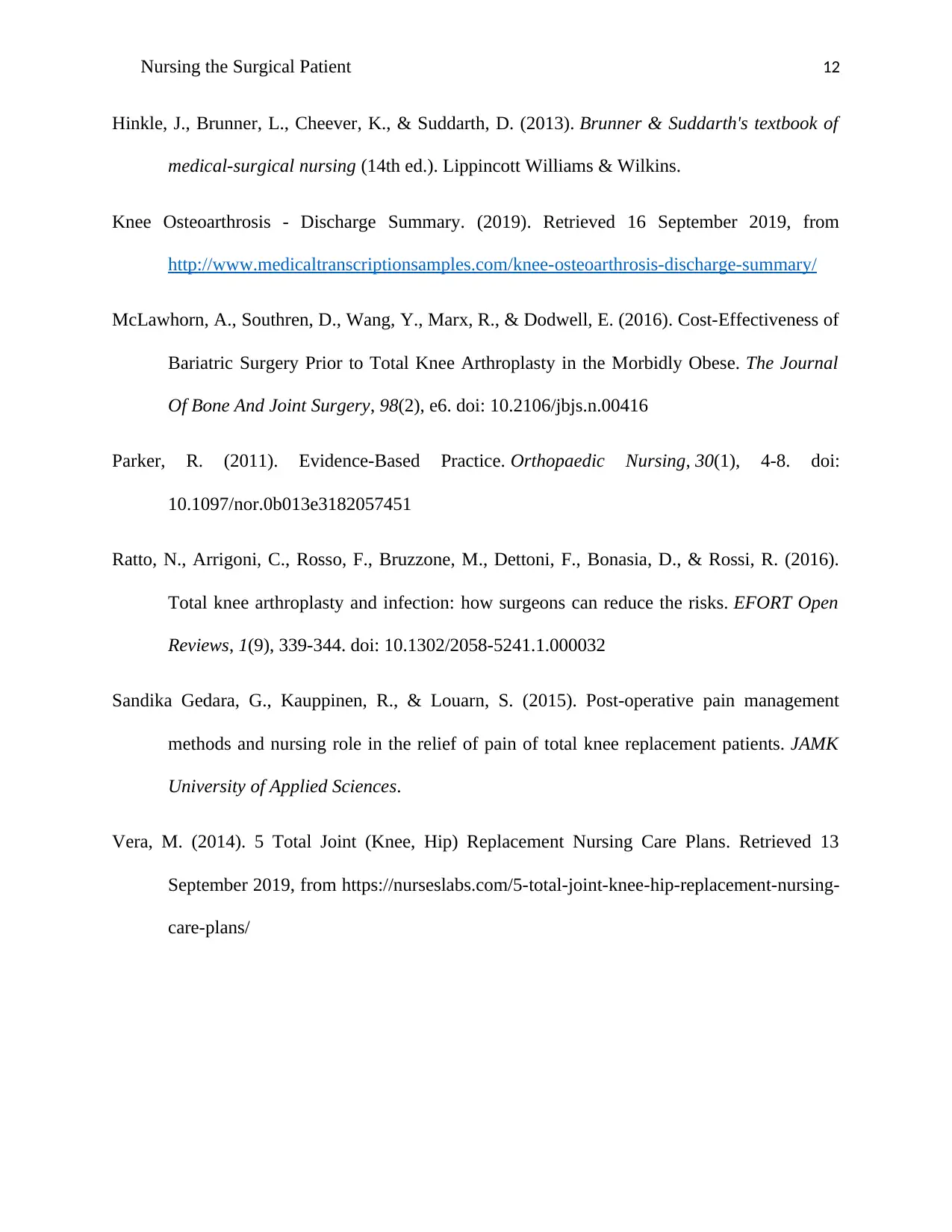
Nursing the Surgical Patient 12
Hinkle, J., Brunner, L., Cheever, K., & Suddarth, D. (2013). Brunner & Suddarth's textbook of
medical-surgical nursing (14th ed.). Lippincott Williams & Wilkins.
Knee Osteoarthrosis - Discharge Summary. (2019). Retrieved 16 September 2019, from
http://www.medicaltranscriptionsamples.com/knee-osteoarthrosis-discharge-summary/
McLawhorn, A., Southren, D., Wang, Y., Marx, R., & Dodwell, E. (2016). Cost-Effectiveness of
Bariatric Surgery Prior to Total Knee Arthroplasty in the Morbidly Obese. The Journal
Of Bone And Joint Surgery, 98(2), e6. doi: 10.2106/jbjs.n.00416
Parker, R. (2011). Evidence-Based Practice. Orthopaedic Nursing, 30(1), 4-8. doi:
10.1097/nor.0b013e3182057451
Ratto, N., Arrigoni, C., Rosso, F., Bruzzone, M., Dettoni, F., Bonasia, D., & Rossi, R. (2016).
Total knee arthroplasty and infection: how surgeons can reduce the risks. EFORT Open
Reviews, 1(9), 339-344. doi: 10.1302/2058-5241.1.000032
Sandika Gedara, G., Kauppinen, R., & Louarn, S. (2015). Post-operative pain management
methods and nursing role in the relief of pain of total knee replacement patients. JAMK
University of Applied Sciences.
Vera, M. (2014). 5 Total Joint (Knee, Hip) Replacement Nursing Care Plans. Retrieved 13
September 2019, from https://nurseslabs.com/5-total-joint-knee-hip-replacement-nursing-
care-plans/
Hinkle, J., Brunner, L., Cheever, K., & Suddarth, D. (2013). Brunner & Suddarth's textbook of
medical-surgical nursing (14th ed.). Lippincott Williams & Wilkins.
Knee Osteoarthrosis - Discharge Summary. (2019). Retrieved 16 September 2019, from
http://www.medicaltranscriptionsamples.com/knee-osteoarthrosis-discharge-summary/
McLawhorn, A., Southren, D., Wang, Y., Marx, R., & Dodwell, E. (2016). Cost-Effectiveness of
Bariatric Surgery Prior to Total Knee Arthroplasty in the Morbidly Obese. The Journal
Of Bone And Joint Surgery, 98(2), e6. doi: 10.2106/jbjs.n.00416
Parker, R. (2011). Evidence-Based Practice. Orthopaedic Nursing, 30(1), 4-8. doi:
10.1097/nor.0b013e3182057451
Ratto, N., Arrigoni, C., Rosso, F., Bruzzone, M., Dettoni, F., Bonasia, D., & Rossi, R. (2016).
Total knee arthroplasty and infection: how surgeons can reduce the risks. EFORT Open
Reviews, 1(9), 339-344. doi: 10.1302/2058-5241.1.000032
Sandika Gedara, G., Kauppinen, R., & Louarn, S. (2015). Post-operative pain management
methods and nursing role in the relief of pain of total knee replacement patients. JAMK
University of Applied Sciences.
Vera, M. (2014). 5 Total Joint (Knee, Hip) Replacement Nursing Care Plans. Retrieved 13
September 2019, from https://nurseslabs.com/5-total-joint-knee-hip-replacement-nursing-
care-plans/
1 out of 12
Related Documents
Your All-in-One AI-Powered Toolkit for Academic Success.
+13062052269
info@desklib.com
Available 24*7 on WhatsApp / Email
![[object Object]](/_next/static/media/star-bottom.7253800d.svg)
Unlock your academic potential
© 2024 | Zucol Services PVT LTD | All rights reserved.





